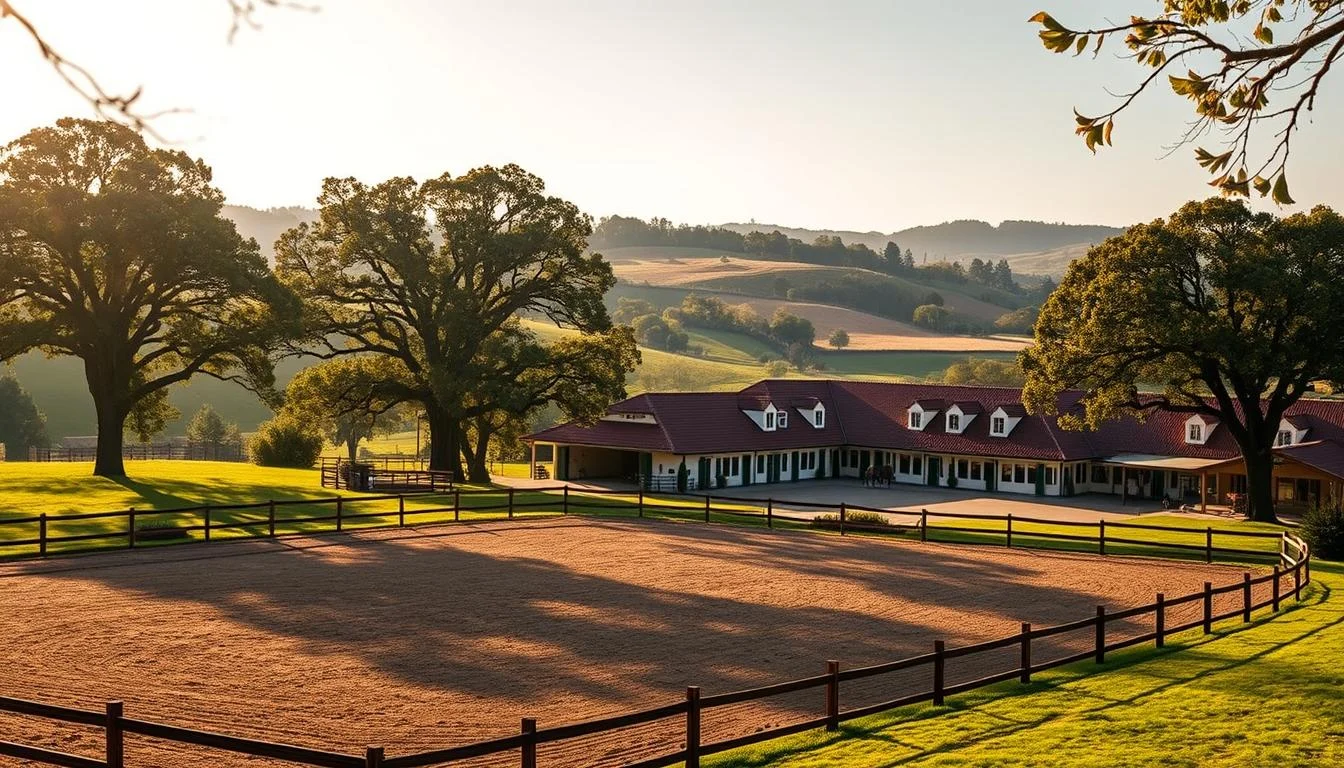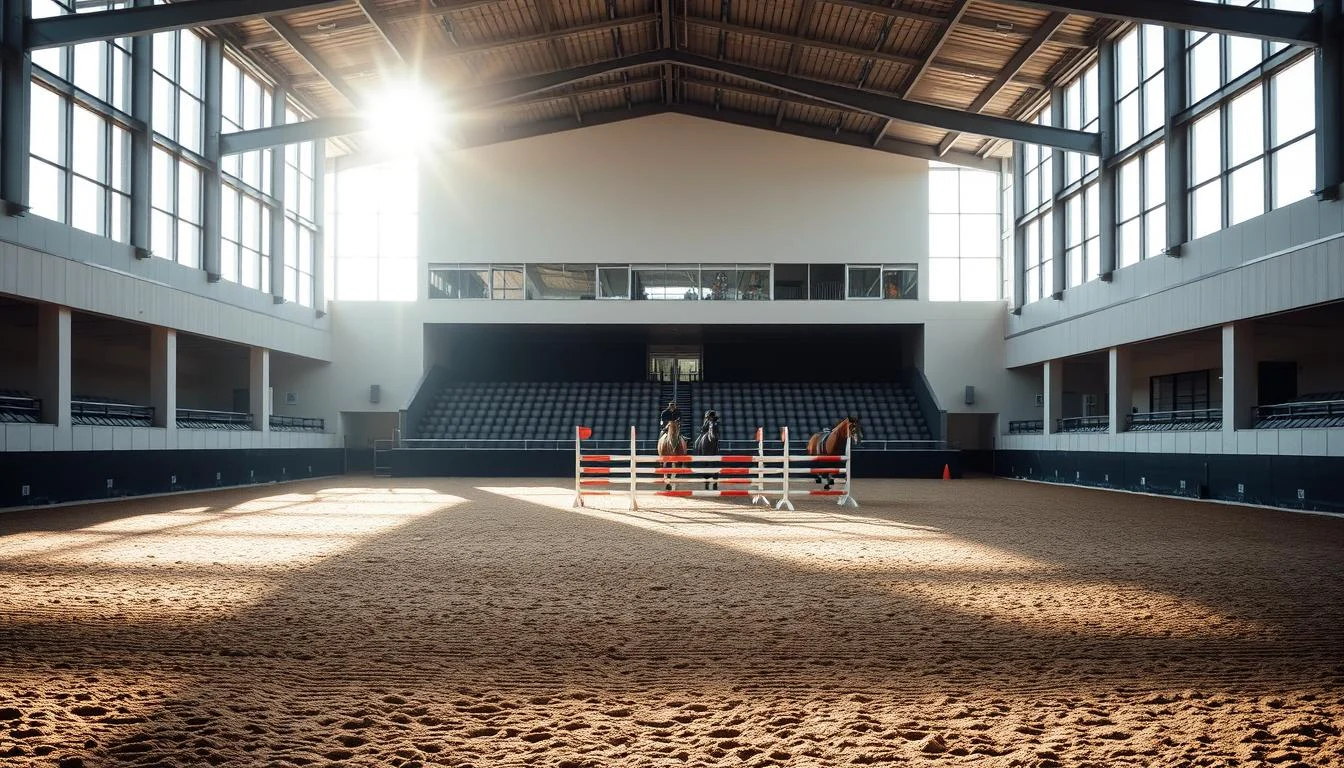Did you know that over 60% of horse owners report noticeable improvements in their animal’s health and performance after moving to a well-equipped center? Whether you’re a competitive rider or simply enjoy leisurely trails, the right environment shapes your horse’s well-being and your riding experience.
Take First Choice Equestrian Center, for example. Their focus on spacious stalls, safe arenas, and experienced trainers has made them a trusted name. But what makes a location truly ideal? It’s more than just clean stables—think about bonding opportunities, training programs, and access to trails or competition-ready spaces.
This guide walks you through key factors like safety protocols, staff qualifications, and community vibes. You’ll learn how to spot red flags and prioritize amenities that match your goals. From beginners to seasoned riders, everyone deserves a place where their horse thrives.
Key Takeaways
- A quality center boosts your horse’s health, training, and rider connection.
- Look for clean, safe spaces like arenas, trails, and well-maintained stalls.
- Experienced staff and trainers are non-negotiable for safety and progress.
- Community events and clinics add value beyond basic amenities.
- Location matters—balance convenience with access to specialized services.
The Importance of a Quality Equestrian Facility
Imagine a place where every detail supports your horse’s health and your riding goals—that’s what a great facility offers. It’s not just about shiny barns or fancy equipment. True quality means safe spaces, smart design, and staff who prioritize both animal welfare and rider growth.

Why Riders Thrive in Superior Spaces
Modern arenas with proper footing reduce injury risks while helping horses move naturally. Centers like Green Valley Equestrian—praised in 92% of online reviews—show how daily arena maintenance leads to better jumps and smoother gaits. Certified instructors here help riders master techniques 30% faster than average programs.
Look for these signs of excellence:
| Feature | Standard Center | Quality Center |
|---|---|---|
| Arena Maintenance | Irregular inspections | Daily surface grooming |
| Staff Certification | Basic training | Certified instructors |
| Horse Care | Standard feeding | Custom nutrition plans |
Shared Benefits for Horse and Human
When stalls are cleaned twice daily and turnout schedules match each horse’s needs, you’ll see fewer vet visits and shinier coats. Owners gain peace of mind knowing their partner gets personalized care. Plus, clinics on topics like hoof care or dressage basics turn riders into informed advocates for their animals.
The best centers create win-win situations. They blend safety protocols with fun extras like trail networks or show-prep workshops. This balance keeps horses engaged and owners excited to learn—building partnerships that last years.
Key Features and Amenities of Top Equestrian Centers
Top centers blend innovation with practicality to create spaces where horses and riders excel. Let’s explore the elements that set exceptional locations apart.

Modern Arenas and Specialized Training Areas
High-quality arenas form the backbone of any great center. The best use advanced footing materials like silica sand mixed with synthetic fibers. This combo absorbs impact while providing grip—key for disciplines like jumping or dressage.
Specialized areas matter too. Look for:
- Adjustable jump courses with technical layouts
- Dressage rings marked with precise letters
- Round pens for groundwork training
Centers like Alberta’s Rocky Mountain Ranch prove this approach works. Their riders achieve 25% fewer injuries thanks to arena surfaces groomed daily.
Boarding Options, Stables, and Additional Services
From full-care packages to DIY stalls, boarding plans should match your lifestyle. Full-service options often include:
| Service | Standard | Premium |
|---|---|---|
| Feed | Basic hay | Custom grain blends |
| Turnout | Group fields | Individual paddocks |
| Health Checks | Daily | Twice daily + vet access |
Well-designed stables go beyond clean stalls. Climate-controlled tack rooms, 24/7 water access, and secure storage show a center’s commitment. As local rider Clara M. notes: “When my horse has a home that feels safe, our training sessions become breakthroughs.”
Choosing Equestrian Facility: Safety, Staff, and Horse Care
Your horse’s well-being hinges on three pillars: safety, skilled staff, and consistent care. Centers that excel in these areas create environments where animals flourish and riders gain confidence through expert guidance.
Why Expertise Matters in Every Interaction
Certified instructors do more than teach riding—they spot early signs of lameness or stress. Look for barns where staff hold credentials like CHA certification or Equine Canada accreditation. These professionals adjust training plans based on each horse’s needs and rider goals.
| Staff Qualification | Basic Center | Top-Tier Center |
|---|---|---|
| Training Updates | Yearly workshops | Monthly skill clinics |
| Emergency Prep | First aid kits | On-site vet partnerships |
| Turnout Supervision | Daily checks | Live pasture cameras |
Daily Care That Keeps Horses Thriving
Sunrise Stables in Ontario sets the standard with their 6-point wellness system. Horses here enjoy:
- Twice-daily grooming sessions
- Custom feed mixes adjusted weekly
- 72-hour illness response guarantees
“Our team treats every horse like family,” says manager Lila Chen. “We track weight, coat condition, and hoof health daily—it’s how we catch issues before they become emergencies.”
Regular turnout schedules prevent stiffness, while vaccination logs and dental checks stay updated. When staff and care protocols work together, you’ll spend less time worrying and more time enjoying your partnership.
Location, Accessibility, and Community Impact
Finding the perfect spot isn’t just about convenience—it shapes how you and your horse live. A well-placed center saves hours each week, letting you focus on riding goals instead of traffic jams. Let’s explore how smart planning creates thriving partnerships between riders and their surroundings.
Convenience and Surrounding Infrastructure
Quick access to feed stores or vet clinics means fewer rushed trips. Centers near highways or maintained backroads cut travel time by 40% in areas like Ontario’s horse country. Look for these infrastructure essentials:
| Feature | Standard | Ideal |
|---|---|---|
| Road Quality | Gravel paths | Paved access roads |
| Fencing | Basic wire | Wooden/vinyl safety rails |
| Water Access | Shared troughs | Automatic waterers |
Proximity matters beyond practicality. One Alberta rider shared: “When my barn is 10 minutes from home, I ride daily—even after work.” This consistency builds trust and progress.
Building a Supportive Equestrian Community
Great neighbors make great barns. Communities like British Columbia’s Maple Ridge host trail-cleaning days and skill swaps. These events turn strangers into teammates who share trailers or recommend farriers.
Affordable lot sizes and group hay purchases help riders manage costs. But the real value? Shared joy—like watching kids gallop together at local shows or veterans bonding over groundwork clinics. As one Manitoba trainer puts it: “We grow faster when we root for each other.”
Conclusion
Your horse’s home shapes every ride and every milestone. Prioritize safety protocols, skilled staff, and daily care routines that keep your partner thriving. Quality boarding services with clean stalls, fresh water access, and modern arenas directly impact your horse’s condition and training progress.
A great center balances practical factors like location and price with community-driven perks. Supportive barns host clinics where riders share tips or troubleshoot jumps. These spaces become second homes for both horse lovers and their animals.
Always visit potential locations. Walk the stalls, test arena footing, and ask about emergency plans. The right choice strengthens your bond while opening doors to dressage workshops or trail adventures.
Remember: your horse’s well-being fuels your growth as a rider. By focusing on their needs and your goals, you’ll find a place where trust gallops forward—one happy hoofbeat at a time.
FAQ
What factors should I prioritize when selecting a horse boarding center?
Focus on amenities like well-maintained arenas, safe stalls, and access to trails. Check the staff’s expertise in horse care, emergency protocols, and whether services like grooming or veterinary support are available. Location and community vibe also matter.
How does a high-quality riding center benefit both riders and horses?
Top-tier centers offer structured training programs, quality feed, and clean water, which keep horses healthy. Riders gain from professional coaching, safe arenas for jumping or dressage, and access to trails. It creates a stress-free environment for both.
What amenities do leading barns provide beyond basic stables?
Look for covered or outdoor arenas with footing suited for disciplines like dressage. Many offer wash racks, tack rooms, and round pens. Some include extras like on-site trainers, lesson programs, or access to nearby trails for varied riding experiences.
Why is staff experience critical for a safe equestrian environment?
Knowledgeable teams spot health issues early, manage emergencies, and ensure proper feed schedules. They maintain clean stalls, monitor herd dynamics, and adjust care based on seasonal needs. Experienced instructors also tailor lessons to rider skill levels.
How does a center’s location impact daily horse management?
Proximity to your home reduces commute time for daily checks. Easy highway access helps during vet visits or competitions. Centers near open fields or trails provide diverse riding opportunities, while nearby communities often host clinics or social events.
Can a riding barn’s community enhance my experience?
Absolutely! A supportive network offers camaraderie, shared knowledge, and group trail rides. Many barns host clinics with professionals like Denny Emerson or host schooling shows. This fosters growth for riders and builds trust among horse owners.

